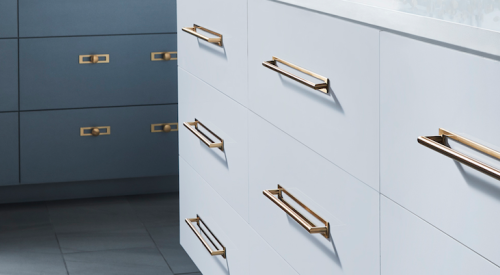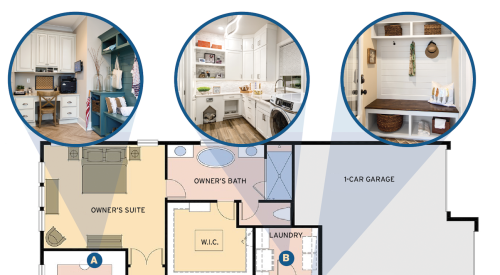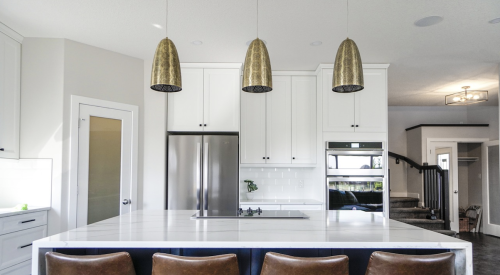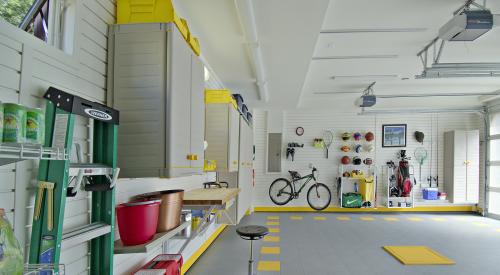Cabinets — they're not just for kitchens and bathrooms anymore. And the ones that are still there are being used in new and creative ways. Necessity is the mother of invention, and homeowners are finding themselves on a relentless quest for more space to put all of their things.
 |
| Located between the master bathroom and the master suite is a bank of cabinets for storage. |
Today's challenge is "making sure that cabinets aren't just a hole with some shelves in them," says Mindy Arnold, interior designer and owner of Your Décor in Lenexa, Kan. "You can really make them functional and hide the things you want to hide, make them store the things you want to store."
Cabinets are traditionally used in kitchens, but are currently being used in more novel ways.
"There are appliance cubbies," says Arnold, "[for] putting your electrical inside the cabinetry. You can open a door and pull out a flat surface on supported rollers that you can put your toaster on, or your blender — those sorts of pieces. And they are plugged inside the cabinets, so that you don't have all those outlets [visible]. You don't have your toaster on your countertop taking up space."
Curling irons and blow dryers similarly take up of counter space in the bathroom. Makeup desk areas with uniquely functional pullouts can help.
"If you pull out what looks like a drawer," says Arnold," instead of pulling it out, it simply slips down. Inside, you have areas where you can [plug] in your blow dryer and your curling iron. You just flip that down and start pulling out your already plugged-in items."
Another use of cabinets, per se, is to camouflage large, freestanding appliances. Overlay panels hide the gleaming metal of modern stainless steel refrigerators, dishwashers and freezers.
Using cabinetry in this way creates uniformity in the space.
"It's seamless," says Derick. "It's integrated into the architecture. There's not a lot of ... mix matched pieces of furniture that stand away from the wall, [or that] are half on, half off the carpet.
Home Offices and Work StationsKitchen cabinet manufacturers are now creating whole walls of bookcases and cabinets that are being used in home offices and studies, enabling builders to offer it to the homebuyer with more ease of production.
"There's an interest in family management centers," says Derick. "If a new home is being built, sometimes they will build a home office, a small one, off the kitchen somewhere."
"When there isn't such a room, sometimes you'll find them cropping up in a walk-in pantry in the kitchen, or in the mudroom area," adds Derick.
Kitchen workstations or tech areas, with space for a computer and file cabinets that match those of the kitchen cabinets, have become quite popular.
However, because of the "inherent messiness of the location," Derick says builders and designers are finding other places to put them.
These workstations have migrated to adjacent areas — like the laundry room.
"We've turned laundries into partial offices," says Anthony Crasi, architect and principle of The Crasi Company. "We've been using the under-the-counter type of washer and dryer, so you can raise the height of the countertop up and have a workspace above it. That's always a nice way to save some space. Then what we do is put a desk in. It has little cubbies in it.
"It's a space where you can close the door if you want to pay the bills, put a computer in there, maybe have a filing cabinet down below,' adds Crasi.
"If the laundry room is large enough," says Derick, "there will be cabinetry not only for supplies but for things like gift wrap. These are utilitarian ways of using cabinetry."
"Oftentimes there is a home loft or a family activity room," she continues, "where the family may do arts and crafts projects together.... You will find those with their own sets of cabinetry in them, often to store away arts and crafts materials, games that the family might play together."
The Master Suite"The owner's suite now comes complete with cabinetry," says Derick, "with a wet bar, a wine center, maybe even a wine refrigerator, coffee bar or a plasma screen TV above a bank of cabinets for the electronics."
"We have the dressing area in the owner's suite," Derick continues. "That would have a bank of cabinets in it for storage, and maybe a vanity area. And then we have the owner's closets...oftentimes with built-in cabinetry. Huge in the custom market and the higher-end market is to have built in cabinetry to hide away all of your accessories — your ties and your shoes, your gloves your scarves your hats your jewelry. And a center island, if the closet is large enough to have storage below, and a place to fold laundry or lay out clothes on top of it."
Secret SpacesCabinets without pulls that blend in to look like walls are a popular trend.
"Traditionally," says Arnold, "there's a fireplace and two built in shelves on the side. Now ... when you push on it, there are doors that open. So there is a closed flat wall with some nice paneling on it or something decorative, and what you do is push on a section of it, and it pops the door open. There's a TV in there or extra storage space."
Let no space go unused, even under the stairway.
"The space under the staircase used to be wasted," says Arnold. "because architecturally it didn't work for anything. Now they are keeping that open. maybe the office that's sitting there has a bookcase in it that you can pull on the shelf and the bookcase opens and there's a room back there. ... the wall moves, so you can get to those spaces.
"Even if it's a really weird little cubby," says Arnold. "don't forget it, because it can be something useful."










